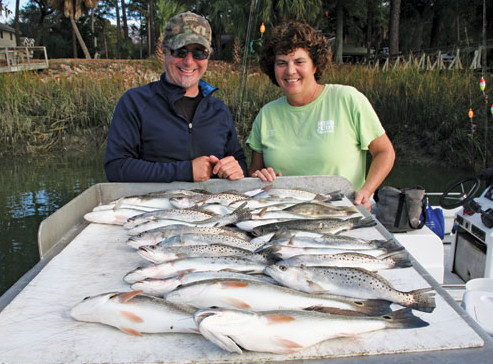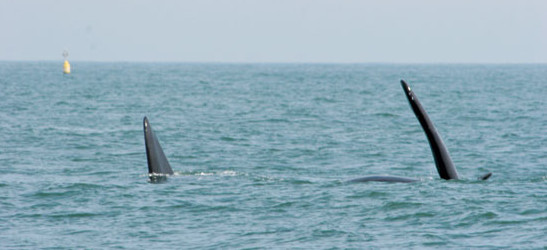
Even with February being one of the coldest months on the coast there are still plenty of catching opportunities!
Inshore fishing can be very good for red fish, but you need to keep in mind that the water is a lot clearer, causing the fish to be a bit more skittish. When in the fishing mode, I suggest keeping as quiet as possible. A plan is the key to successfully finding and catching red fish.
Pick areas in the sounds where sloughs flow onto bars or flats. The best fishing spots should have at least six inches of water at mean low tide. The best days are going to be those that have a mid-day low tide stage with sunny conditions. I like to fish the bottom of the low tide stage until the water floods the grass.
Another reason why I like to fish low to high tide is the water under your boat gets deeper not shallower. No one wants to spend the day “high and dry” on a sand bar.
For best baits when it comes to the natural stuff, I suggest chunked shrimp and whole mullet cut in pieces like a loaf of bread. I always suggest cutting the bait before heading out. The best place to put cut bait is out in the air and direct sun. This dries the bait sealing in the fishy juices, which rings the dinner bell for a red fish once the bait is placed back in the water.
When using natural baits, all you need is 12 to 15 inches of 15- to 20-pound test fluorocarbon leader tied to a small extra sharp circle hook. Cast into the area, let the bait fall to the bottom, and wait for a hit. Before setting the hook, give them time to eat. Here’s a great rule of thumb to go by: “The colder the water temperature the lighter the bite!”
Offshore Fishing Report
It’s offshore trophy red fish catching time!
The secret to catching is to know the deal, which I am going to share with you right now. Most of these trophy red fish that have migrated offshore during this time of the year are in the 27- to 45-inch and bigger range. The best place to start looking is at the near shore Georgia artificial reefs located in up to 50 feet of water. A few artificial reefs off the Georgia coast that have been holding some nice trophy fish include: SAV, DUA, CAT, KC, and KTK.
The best places to anchor are over barges or pallet balls. Since most artificial reefs are no longer marked with yellow reef buoys, when researching coordinates I suggest using only the ones that mark the actual places that you want to anchor. For up-to-date information on Georgia artificial reefs, go to www.coastalgadnr.org/node/2089.

Right Whale Wirls
It’s time to do a little whale watching! Right whales need our help. Report sightings of dead, injured or entangled whales to (877)942-5343 or to the U.S. Coast Guard via channel 16.
Over the years I have had lots of close encounters with right whales! During this time of year, the Georgia coast is frequented by migrating adult whales along with their new born calves. After birthing in more southern waters, these beautiful creatures move north while hugging the coast. They are known for staying close to the surface, making them unfortunate navigational hazards.
When navigating the offshore waters during this time, I am always looking for any whale swirls or trails. When a whale is making way, its tail normally causes quite a stir in the water column, especially when it swirls near the bottom. Sediments are moved around creating a target rich feeding environment for bait fish and all sorts of sea birds. Hence, where you have lots of birds diving and dolphins breaking the surface in large numbers, whales could be in the area.
If a right whale approaches you, by law boaters are “required” to move away from the whales. The very next thing that you need to do is contact the Coast Guard or have someone relay coordinates of your whale encounter. The reason is simple: it could save their life! The Coast Guard will contact proper sources so that coordinates can be sent to boats/ships that are navigating in the area of the sighting.
For right whales that you happen upon, please keep your distance. You are required by law to maintain a distance of at least 500 yards. The reason being, a collision with one might cause serious injury or death to the whale. At last count there were less than 360 of these precious mammals left in the North Atlantic Ocean.




